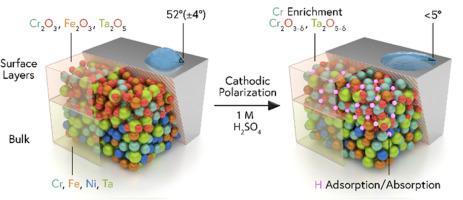Hydrogen induced superhydrophilicity in an amorphous CrFeNi-based multi-principal element alloy thin film
IF 8.3
1区 材料科学
Q1 MATERIALS SCIENCE, MULTIDISCIPLINARY
引用次数: 0
Abstract
The compelling nature of the highly adapted functional surface structures found in biological systems accompanied by delicately tuned chemical processes, has inspired the design of materials with varied wetting properties and a vast range of applications. Identifying relations between surface structure, chemistry and wettability, is pivotal towards the mechanistic understanding of wetting phenomena. Here we demonstrate how electrochemically driven hydrogen adsorption/absorption induces, irreversibly, a superhydrophilic state in an amorphous CrFeNi-based multi-principal element alloy thin film with close to equimolar composition, i.e., in the class of medium/high entropy alloys. By employing films with sub-nanometer roughness to exclude the influence of geometry on wetting, we show that both the extent of wetting and its dynamics are governed by the rate of the underlying electrochemical reactions. The absorption of hydrogen into the matrix of the amorphous films as proved by thermal desorption spectroscopy, is proposed to partially protonate the electrochemically resilient Ta and Cr surface oxides through a hydrogen spillover phenomenon initiated by the adsorption of hydrogen on the electrochemically reduced Fe sites. Furthermore, atom probe tomography measurements reveal Cr segregation at the outermost surface layers of the film following cathodic treatment. The above processes strongly influence surface energetics resulting in the transition from a mildly hydrophilic state to an ultra-high substrate surface energy regime. Our work establishes a previously unknown physicochemical link between multi-principal element-alloys – hydrogen interactions and surface wettability, that is of significance in frontline research areas spanning electrochemical energy conversion/storage and catalysis to materials degradation and liquids actuation.


非晶crfeni基多主元素合金薄膜的氢致超亲水性
在生物系统中发现的高度适应的功能表面结构的令人信服的性质伴随着精细调整的化学过程,激发了具有不同润湿性能和广泛应用范围的材料的设计。确定表面结构、化学和润湿性之间的关系,对润湿现象的机理理解至关重要。在这里,我们展示了电化学驱动的氢吸附/吸收如何在接近等摩尔成分的无定形crfeni基多主元素合金薄膜(即中/高熵合金)中不可逆地诱导超亲水状态。通过采用亚纳米粗糙度的薄膜来排除几何形状对润湿的影响,我们发现润湿的程度及其动力学都受潜在电化学反应的速率控制。热解吸光谱证实了氢在非晶膜基体中的吸附作用,通过氢在电化学还原的Fe位点上的吸附引发的氢溢出现象,使电化学弹性的Ta和Cr表面氧化物部分质子化。此外,原子探针层析测量显示,阴极处理后,在膜的最外层存在Cr偏析。上述过程强烈影响表面能量,导致从温和亲水状态到超高底物表面能状态的转变。我们的工作在多主要元素-合金-氢相互作用和表面润湿性之间建立了以前未知的物理化学联系,这在跨越电化学能量转换/存储和催化材料降解和液体驱动的前沿研究领域具有重要意义。
本文章由计算机程序翻译,如有差异,请以英文原文为准。
求助全文
约1分钟内获得全文
求助全文
来源期刊

Acta Materialia
工程技术-材料科学:综合
CiteScore
16.10
自引率
8.50%
发文量
801
审稿时长
53 days
期刊介绍:
Acta Materialia serves as a platform for publishing full-length, original papers and commissioned overviews that contribute to a profound understanding of the correlation between the processing, structure, and properties of inorganic materials. The journal seeks papers with high impact potential or those that significantly propel the field forward. The scope includes the atomic and molecular arrangements, chemical and electronic structures, and microstructure of materials, focusing on their mechanical or functional behavior across all length scales, including nanostructures.
 求助内容:
求助内容: 应助结果提醒方式:
应助结果提醒方式:


